stop start BMW ACTIVE HYBRID 7 2013 F04 Owner's Guide
[x] Cancel search | Manufacturer: BMW, Model Year: 2013, Model line: ACTIVE HYBRID 7, Model: BMW ACTIVE HYBRID 7 2013 F04Pages: 253, PDF Size: 5.01 MB
Page 123 of 253

lision with pedestrians and includes a braking
function.
The system is controlled via the camera in the
base of the interior mirror.
General information
The system issues a warning with brightness
staring at approx. 6 mph/10 km/h to approx.
35 mph/60 km/h regarding a possible risk of
collision with pedestrians and assists with a
brake intervention shortly before a collision.
It responds to persons that are within the de‐
tection range of the system.
Detection range
The warning area in front of the vehicle is div‐
ided into two areas.
▷Central area, arrow 1, directly in front of the
vehicle.▷Expanded area, arrow 2, to the right and
left.
A collision is imminent if pedestrians are lo‐
cated within the central area. A warning is is‐
sued about pedestrians who are located within
the extended area only if they are moving in
the direction of the central area.
At a glance
Button in the vehicle
Intelligent Safety button
Camera
The camera is located near the base of the
mirror.
Keep the windshield in the area behind the in‐
terior rear view mirror clean and clear.
Switching on/off
Switching on automatically The system is automatically active every time
the engine is started using the Start/Stop but‐
ton.
Switching off Press the button: the systems are
switched off. The LED goes out.
Press the button: the systems are switched off.
The LED lights up.
Seite 119SafetyControls119
Online Edition for Part no. 01 40 2 909 774 - VI/13
Page 124 of 253
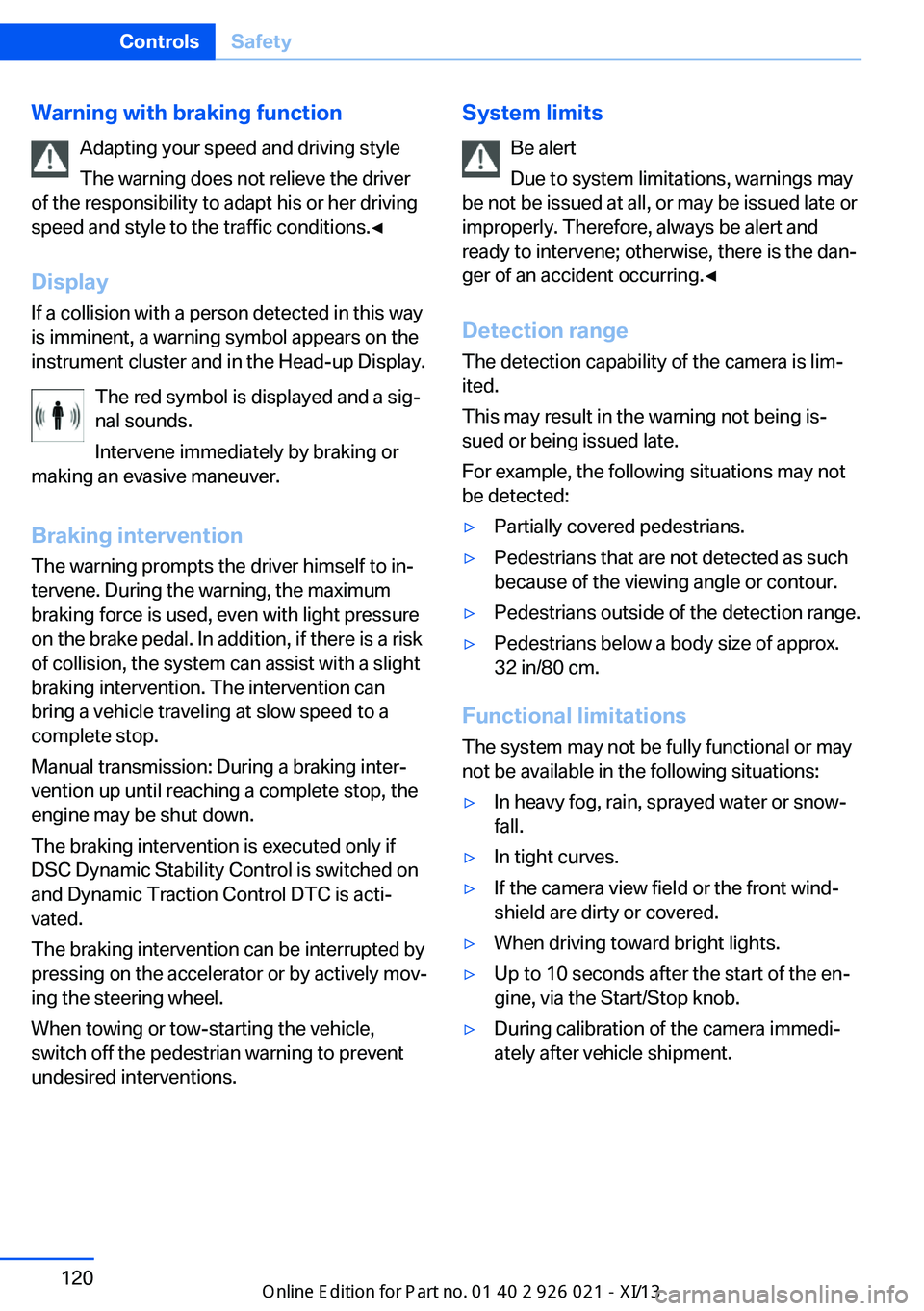
Warning with braking functionAdapting your speed and driving style
The warning does not relieve the driver
of the responsibility to adapt his or her driving
speed and style to the traffic conditions.◀
Display If a collision with a person detected in this way
is imminent, a warning symbol appears on the
instrument cluster and in the Head-up Display.
The red symbol is displayed and a sig‐
nal sounds.
Intervene immediately by braking or
making an evasive maneuver.
Braking intervention
The warning prompts the driver himself to in‐
tervene. During the warning, the maximum
braking force is used, even with light pressure
on the brake pedal. In addition, if there is a risk
of collision, the system can assist with a slight
braking intervention. The intervention can
bring a vehicle traveling at slow speed to a
complete stop.
Manual transmission: During a braking inter‐
vention up until reaching a complete stop, the
engine may be shut down.
The braking intervention is executed only if
DSC Dynamic Stability Control is switched on
and Dynamic Traction Control DTC is acti‐
vated.
The braking intervention can be interrupted by
pressing on the accelerator or by actively mov‐
ing the steering wheel.
When towing or tow-starting the vehicle,
switch off the pedestrian warning to prevent
undesired interventions.System limits
Be alert
Due to system limitations, warnings may
be not be issued at all, or may be issued late or
improperly. Therefore, always be alert and
ready to intervene; otherwise, there is the dan‐
ger of an accident occurring.◀
Detection range
The detection capability of the camera is lim‐
ited.
This may result in the warning not being is‐
sued or being issued late.
For example, the following situations may not
be detected:▷Partially covered pedestrians.▷Pedestrians that are not detected as such
because of the viewing angle or contour.▷Pedestrians outside of the detection range.▷Pedestrians below a body size of approx.
32 in/80 cm.
Functional limitations
The system may not be fully functional or may
not be available in the following situations:
▷In heavy fog, rain, sprayed water or snow‐
fall.▷In tight curves.▷If the camera view field or the front wind‐
shield are dirty or covered.▷When driving toward bright lights.▷Up to 10 seconds after the start of the en‐
gine, via the Start/Stop knob.▷During calibration of the camera immedi‐
ately after vehicle shipment.Seite 120ControlsSafety120
Online Edition for Part no. 01 40 2 909 774 - VI/13
Page 126 of 253

NotesPersonal responsibility
Night Vision cannot replace the driver's
personal judgment of the visibility conditions
and the traffic situation. The view ahead and the actual visibility conditions must always be
the basis on which the vehicle speed is ad‐ justed; otherwise, there is a risk to road
safety.◀
At a glance
Buttons in the vehicle
Intelligent Safety button
Switch on/switch off heat image
Camera
The camera is automatically heated when the
external temperatures are low.
The camera is automatically cleaned together
with the headlamps.
Switching on/off
Switching on automatically Every time the engine is started using the
Start/Stop button, the system is automatically
active at dark.
Switching off The system is only switched off until the next
time the engine is started with the Start/Stop
button.
Press the button.
The LED goes out.
Switching on heat image additionally The heat image from the Night Vision camera
can also be displayed on the Control Display.
This function has no effect on object detec‐ tion.
Press the button.
The image from the camera is displayed on the
Control Display.
Adjustments via the iDrive With heat image switched on:1.Press the controller.2.Select brightness or contrast.▷ Select the symbol.▷ Select the symbol.3.Turn the controller until the desired setting
is reached, and press the controller.
Display
Warning of people or animals in
danger
If a collision with a person or an animal de‐
tected in this way is imminent, a warning sym‐
bol appears on the instrument cluster and in
the Head-up Display.
Seite 122ControlsSafety122
Online Edition for Part no. 01 40 2 909 774 - VI/13
Page 134 of 253
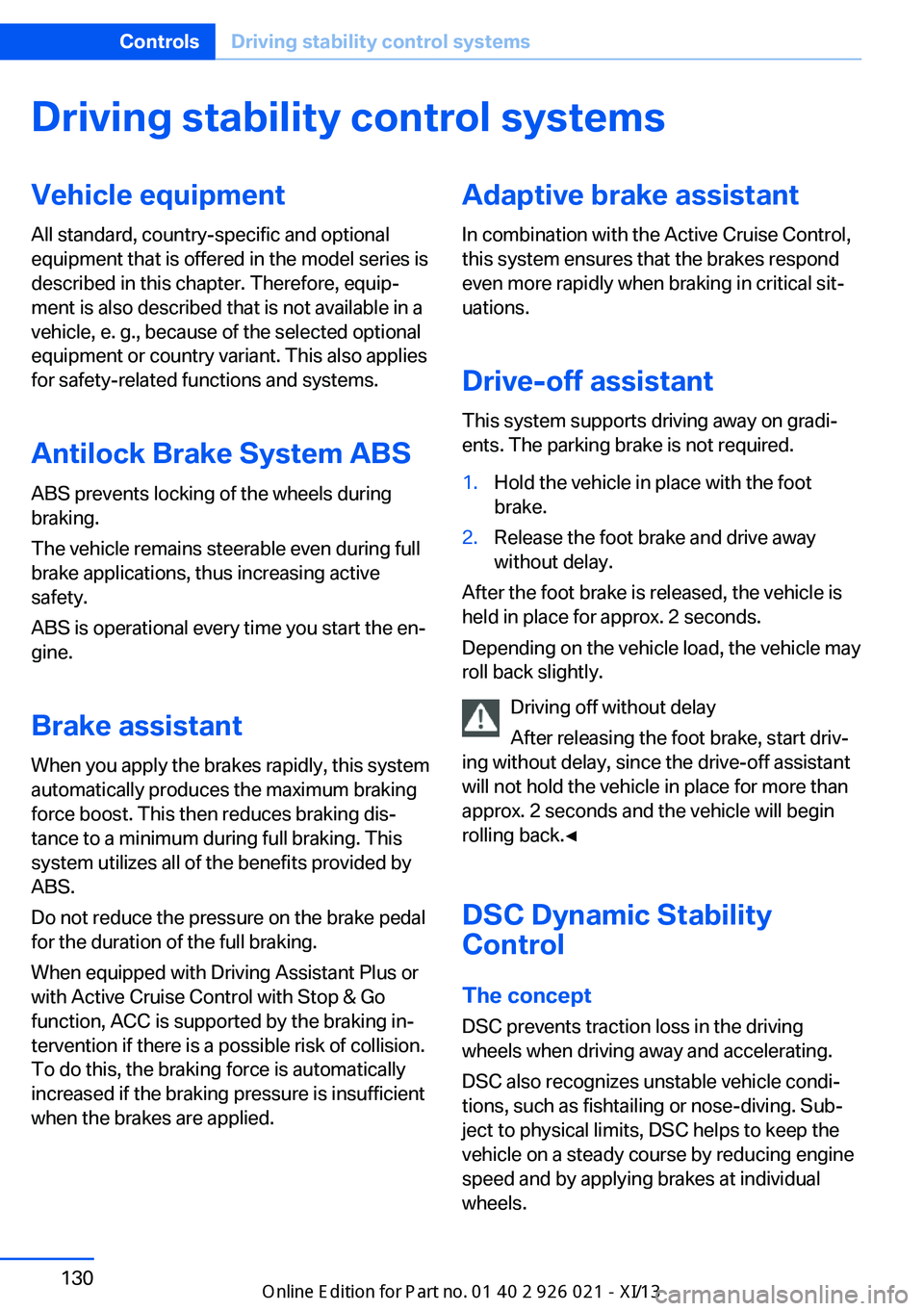
Driving stability control systemsVehicle equipmentAll standard, country-specific and optional
equipment that is offered in the model series is
described in this chapter. Therefore, equip‐
ment is also described that is not available in a
vehicle, e. g., because of the selected optional
equipment or country variant. This also applies
for safety-related functions and systems.
Antilock Brake System ABS ABS prevents locking of the wheels during
braking.
The vehicle remains steerable even during full
brake applications, thus increasing active
safety.
ABS is operational every time you start the en‐
gine.
Brake assistant
When you apply the brakes rapidly, this system
automatically produces the maximum braking
force boost. This then reduces braking dis‐ tance to a minimum during full braking. This
system utilizes all of the benefits provided by ABS.
Do not reduce the pressure on the brake pedal
for the duration of the full braking.
When equipped with Driving Assistant Plus or
with Active Cruise Control with Stop & Go
function, ACC is supported by the braking in‐
tervention if there is a possible risk of collision.
To do this, the braking force is automatically increased if the braking pressure is insufficient
when the brakes are applied.Adaptive brake assistant
In combination with the Active Cruise Control,
this system ensures that the brakes respond
even more rapidly when braking in critical sit‐
uations.
Drive-off assistant
This system supports driving away on gradi‐
ents. The parking brake is not required.1.Hold the vehicle in place with the foot
brake.2.Release the foot brake and drive away
without delay.
After the foot brake is released, the vehicle is
held in place for approx. 2 seconds.
Depending on the vehicle load, the vehicle may
roll back slightly.
Driving off without delay
After releasing the foot brake, start driv‐
ing without delay, since the drive-off assistant
will not hold the vehicle in place for more than
approx. 2 seconds and the vehicle will begin
rolling back.◀
DSC Dynamic Stability
Control
The concept DSC prevents traction loss in the driving
wheels when driving away and accelerating.
DSC also recognizes unstable vehicle condi‐
tions, such as fishtailing or nose-diving. Sub‐
ject to physical limits, DSC helps to keep the
vehicle on a steady course by reducing engine
speed and by applying brakes at individual
wheels.
Seite 130ControlsDriving stability control systems130
Online Edition for Part no. 01 40 2 909 774 - VI/13
Page 185 of 253
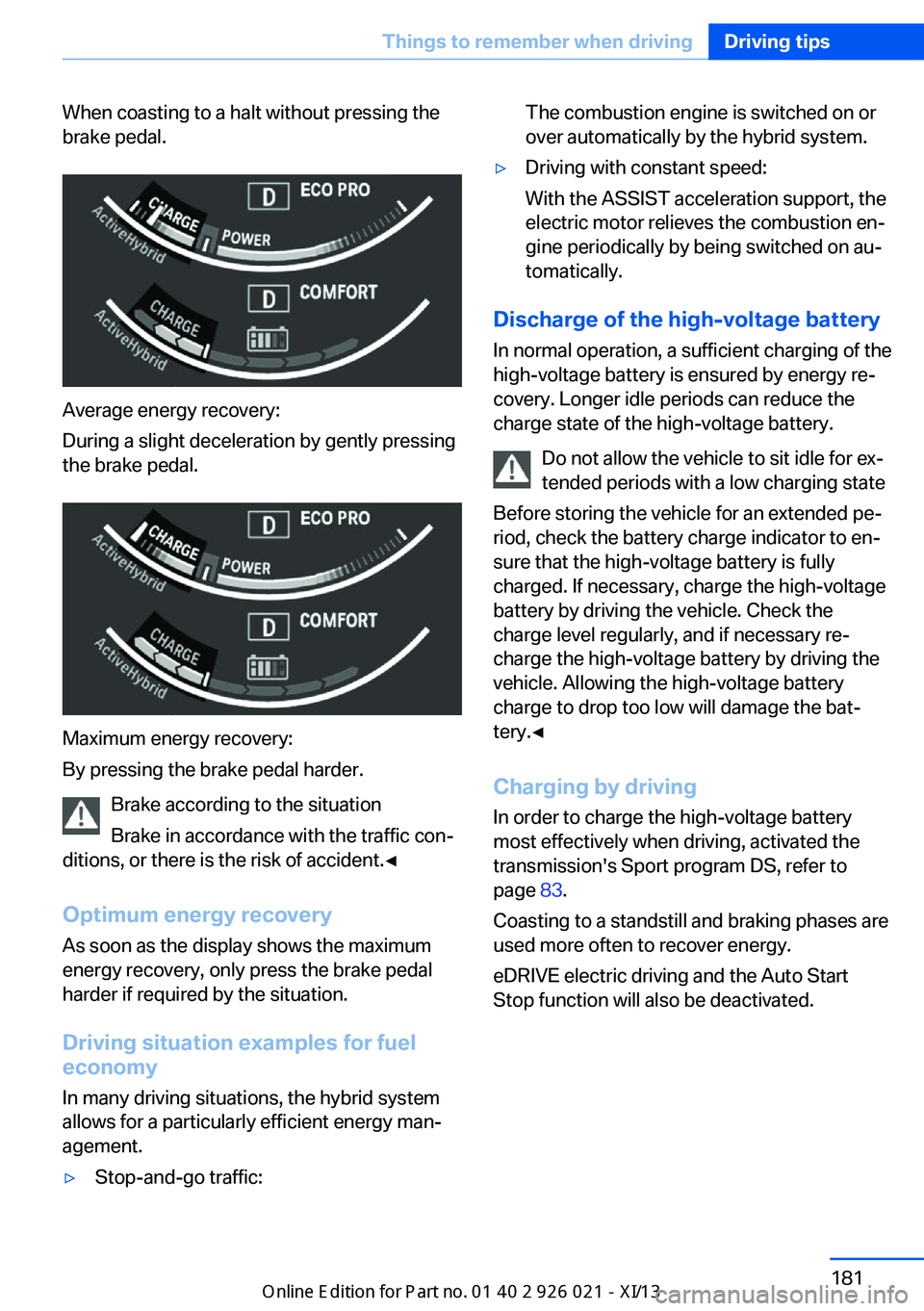
When coasting to a halt without pressing the
brake pedal.
Average energy recovery:
During a slight deceleration by gently pressing
the brake pedal.
Maximum energy recovery:
By pressing the brake pedal harder.
Brake according to the situation
Brake in accordance with the traffic con‐
ditions, or there is the risk of accident.◀
Optimum energy recovery
As soon as the display shows the maximum
energy recovery, only press the brake pedal
harder if required by the situation.
Driving situation examples for fuel
economy
In many driving situations, the hybrid system
allows for a particularly efficient energy man‐
agement.
▷Stop-and-go traffic:The combustion engine is switched on or
over automatically by the hybrid system.▷Driving with constant speed:
With the ASSIST acceleration support, the
electric motor relieves the combustion en‐
gine periodically by being switched on au‐
tomatically.
Discharge of the high-voltage battery
In normal operation, a sufficient charging of the
high-voltage battery is ensured by energy re‐
covery. Longer idle periods can reduce the
charge state of the high-voltage battery.
Do not allow the vehicle to sit idle for ex‐
tended periods with a low charging state
Before storing the vehicle for an extended pe‐
riod, check the battery charge indicator to en‐
sure that the high-voltage battery is fully
charged. If necessary, charge the high-voltage
battery by driving the vehicle. Check the
charge level regularly, and if necessary re‐
charge the high-voltage battery by driving the
vehicle. Allowing the high-voltage battery
charge to drop too low will damage the bat‐
tery.◀
Charging by driving
In order to charge the high-voltage battery
most effectively when driving, activated the
transmission's Sport program DS, refer to
page 83.
Coasting to a standstill and braking phases are
used more often to recover energy.
eDRIVE electric driving and the Auto Start
Stop function will also be deactivated.
Seite 181Things to remember when drivingDriving tips181
Online Edition for Part no. 01 40 2 909 774 - VI/13
Page 232 of 253
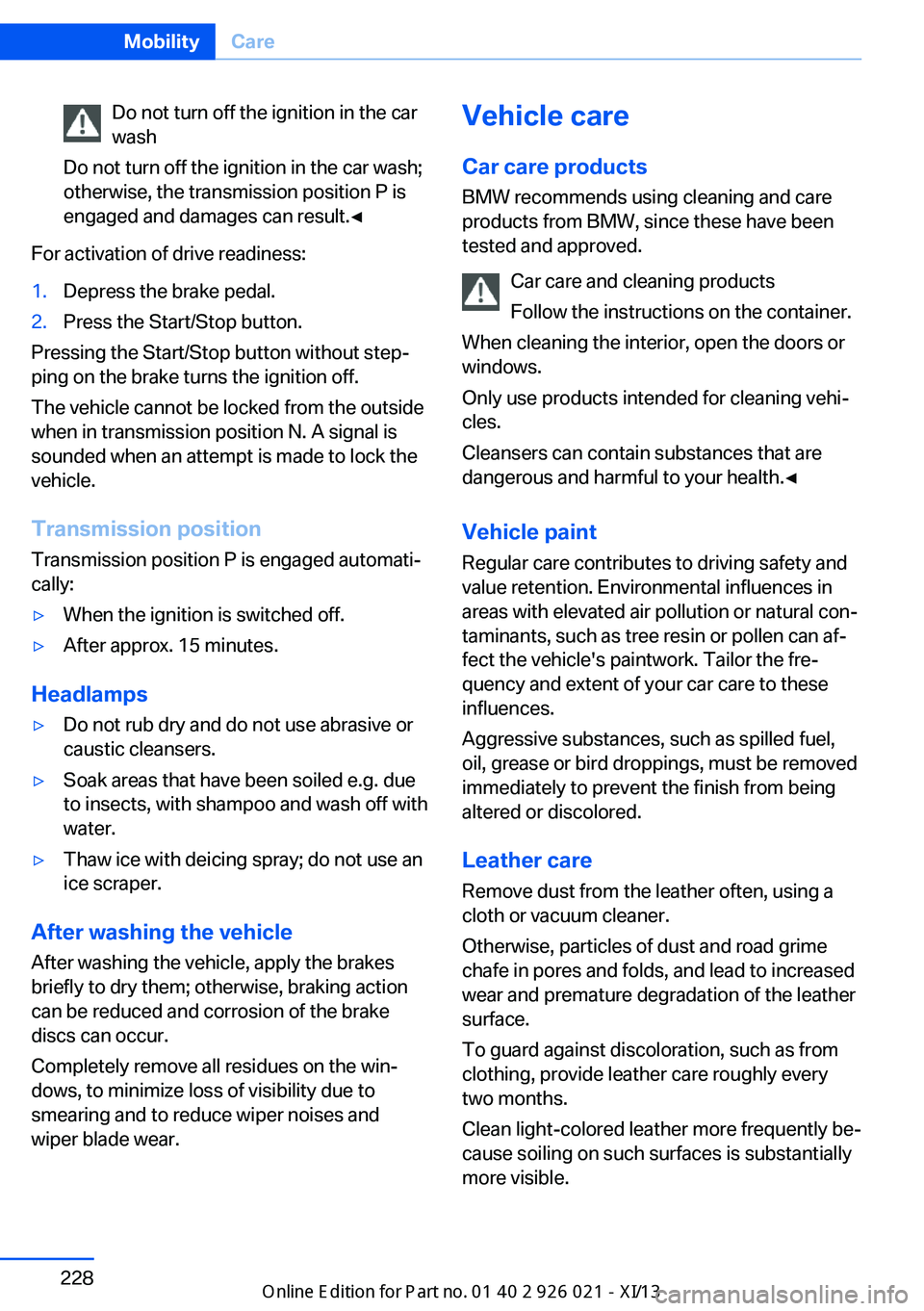
Do not turn off the ignition in the car
wash
Do not turn off the ignition in the car wash;
otherwise, the transmission position P is
engaged and damages can result.◀
For activation of drive readiness:
1.Depress the brake pedal.2.Press the Start/Stop button.
Pressing the Start/Stop button without step‐
ping on the brake turns the ignition off.
The vehicle cannot be locked from the outside
when in transmission position N. A signal is
sounded when an attempt is made to lock the
vehicle.
Transmission position
Transmission position P is engaged automati‐
cally:
▷When the ignition is switched off.▷After approx. 15 minutes.
Headlamps
▷Do not rub dry and do not use abrasive or
caustic cleansers.▷Soak areas that have been soiled e.g. due
to insects, with shampoo and wash off with
water.▷Thaw ice with deicing spray; do not use an
ice scraper.
After washing the vehicle
After washing the vehicle, apply the brakes
briefly to dry them; otherwise, braking action
can be reduced and corrosion of the brake
discs can occur.
Completely remove all residues on the win‐
dows, to minimize loss of visibility due to
smearing and to reduce wiper noises and
wiper blade wear.
Vehicle care
Car care productsBMW recommends using cleaning and care
products from BMW, since these have been
tested and approved.
Car care and cleaning products
Follow the instructions on the container.
When cleaning the interior, open the doors or
windows.
Only use products intended for cleaning vehi‐ cles.
Cleansers can contain substances that are
dangerous and harmful to your health.◀
Vehicle paint Regular care contributes to driving safety and
value retention. Environmental influences in
areas with elevated air pollution or natural con‐
taminants, such as tree resin or pollen can af‐
fect the vehicle's paintwork. Tailor the fre‐
quency and extent of your car care to these
influences.
Aggressive substances, such as spilled fuel,
oil, grease or bird droppings, must be removed
immediately to prevent the finish from being
altered or discolored.
Leather care
Remove dust from the leather often, using a
cloth or vacuum cleaner.
Otherwise, particles of dust and road grime
chafe in pores and folds, and lead to increased
wear and premature degradation of the leather
surface.
To guard against discoloration, such as from
clothing, provide leather care roughly every
two months.
Clean light-colored leather more frequently be‐
cause soiling on such surfaces is substantially
more visible.Seite 228MobilityCare228
Online Edition for Part no. 01 40 2 909 774 - VI/13
Page 242 of 253
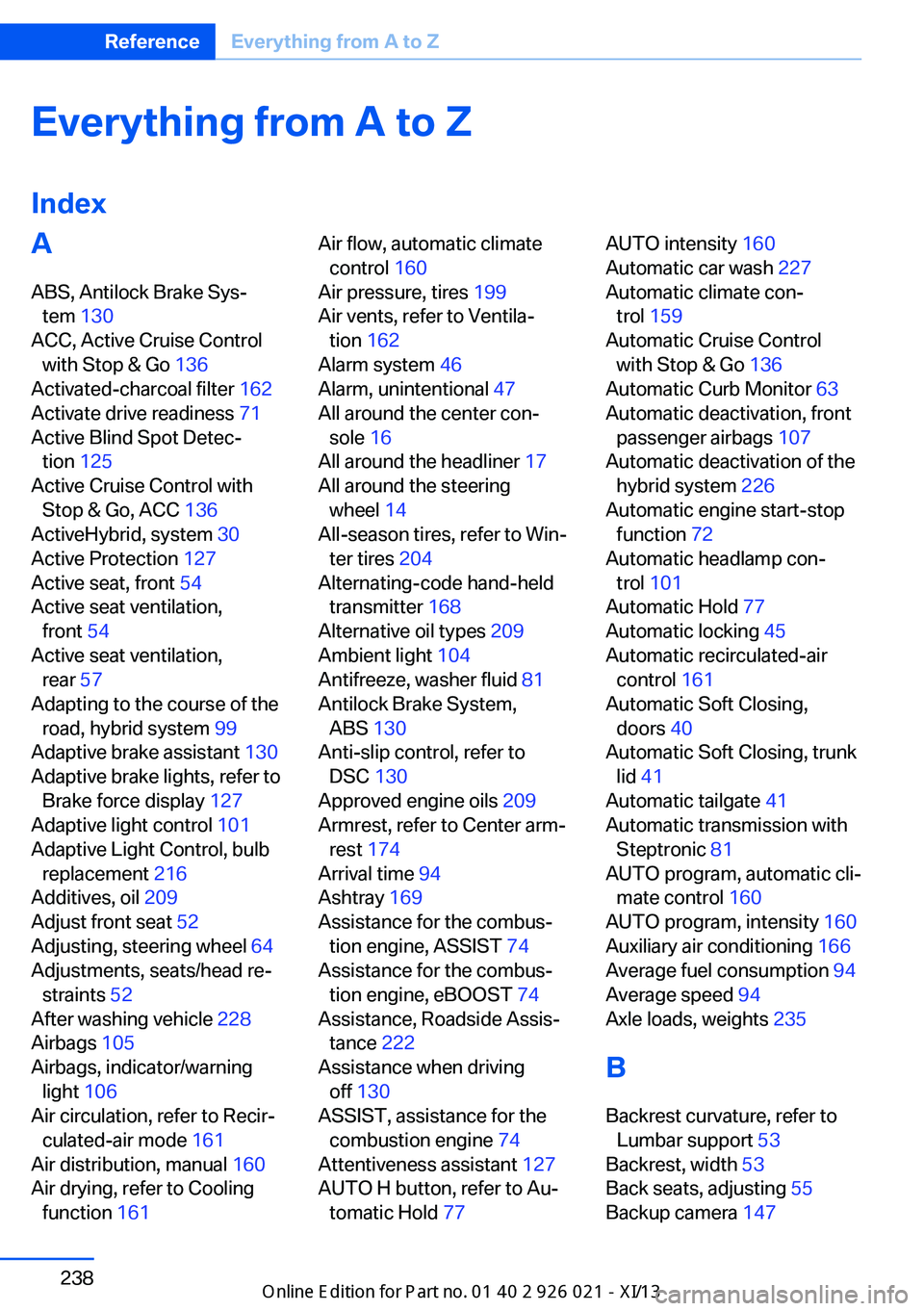
Everything from A to Z
IndexA ABS, Antilock Brake Sys‐ tem 130
ACC, Active Cruise Control with Stop & Go 136
Activated-charcoal filter 162
Activate drive readiness 71
Active Blind Spot Detec‐ tion 125
Active Cruise Control with Stop & Go, ACC 136
ActiveHybrid, system 30
Active Protection 127
Active seat, front 54
Active seat ventilation, front 54
Active seat ventilation, rear 57
Adapting to the course of the road, hybrid system 99
Adaptive brake assistant 130
Adaptive brake lights, refer to Brake force display 127
Adaptive light control 101
Adaptive Light Control, bulb replacement 216
Additives, oil 209
Adjust front seat 52
Adjusting, steering wheel 64
Adjustments, seats/head re‐ straints 52
After washing vehicle 228
Airbags 105
Airbags, indicator/warning light 106
Air circulation, refer to Recir‐ culated-air mode 161
Air distribution, manual 160
Air drying, refer to Cooling function 161 Air flow, automatic climate
control 160
Air pressure, tires 199
Air vents, refer to Ventila‐ tion 162
Alarm system 46
Alarm, unintentional 47
All around the center con‐ sole 16
All around the headliner 17
All around the steering wheel 14
All-season tires, refer to Win‐ ter tires 204
Alternating-code hand-held transmitter 168
Alternative oil types 209
Ambient light 104
Antifreeze, washer fluid 81
Antilock Brake System, ABS 130
Anti-slip control, refer to DSC 130
Approved engine oils 209
Armrest, refer to Center arm‐ rest 174
Arrival time 94
Ashtray 169
Assistance for the combus‐ tion engine, ASSIST 74
Assistance for the combus‐ tion engine, eBOOST 74
Assistance, Roadside Assis‐ tance 222
Assistance when driving off 130
ASSIST, assistance for the combustion engine 74
Attentiveness assistant 127
AUTO H button, refer to Au‐ tomatic Hold 77 AUTO intensity 160
Automatic car wash 227
Automatic climate con‐ trol 159
Automatic Cruise Control with Stop & Go 136
Automatic Curb Monitor 63
Automatic deactivation, front passenger airbags 107
Automatic deactivation of the hybrid system 226
Automatic engine start-stop function 72
Automatic headlamp con‐ trol 101
Automatic Hold 77
Automatic locking 45
Automatic recirculated-air control 161
Automatic Soft Closing, doors 40
Automatic Soft Closing, trunk lid 41
Automatic tailgate 41
Automatic transmission with Steptronic 81
AUTO program, automatic cli‐ mate control 160
AUTO program, intensity 160
Auxiliary air conditioning 166
Average fuel consumption 94
Average speed 94
Axle loads, weights 235
B Backrest curvature, refer to Lumbar support 53
Backrest, width 53
Back seats, adjusting 55
Backup camera 147 Seite 238ReferenceEverything from A to Z238
Online Edition for Part no. 01 40 2 909 774 - VI/13
Page 243 of 253

Band-aids, refer to First aidkit 222
Bar for tow-starting/ towing 224
Basic position, rear seats 56
Battery replacement, vehicle battery 219
Battery replacement, vehicle remote control 34
Battery, vehicle 219
Belts, safety belts 58
Beverage holder, cu‐ pholder 175
Blinds, sun protection 49
BMW ActiveHybrid 30
BMW Assist, see user's manual for Navigation, En‐
tertainment and Communi‐
cation
BMW Homepage 6
BMW Internet page 6
BMW maintenance sys‐ tem 212
Bonus range, ECO PRO 190
Bottle holder, refer to Cu‐ pholder 175
Brake assistant 130
Brake assistant, adaptive 130
Brake discs, breaking in 180
Brake force display 127
Brake lamps, brake force dis‐ play 127
Brake lamps, bulb replace‐ ment 217
Brake lights, adaptive 127
Brake pads, breaking in 180
Braking, hints 183
Breakdown assis‐ tance 221, 222
Breaking in 180
Brightness of Control Dis‐ play 96
Bulb replacement, rear 217
Bulb replacement, see lamp and bulb replacement 214
Button, RES 139 Button, Start/Stop 70
Bypassing, refer to Jump- starting 222
C
California Proposition 65 Warning 8
Calling up mirror adjust‐ ment 46
Calling up seat adjust‐ ment 46
Calling up steering wheel ad‐ justment 46
Camera, backup camera 147
Camera, care 230
Camera, Side View 150
Camera, Top View 151
Can holder, refer to Cu‐ pholder 175
Car battery 219
Car care products 228
Care, displays 230
Care, vehicle 228
Cargo 185
Cargo area lid 40
Cargo area, storage compart‐ ments 175
Cargo, securing 186
Cargo straps, securing cargo 186
Car key, refer to Remote con‐ trol 34
Carpet, care 230
Car wash 227
Catalytic converter, refer to Hot exhaust system 182
CBS Condition Based Serv‐ ice 212
CD/Multimedia, see user's manual for Navigation, En‐
tertainment and Communi‐
cation
Center armrest 174
Center console 16 Center-Lock, see button for
central locking 37
Central locking system 37
Central screen, refer to Con‐ trol Display 18
Changes, technical, refer to Safety 7
Changing parts 214
Changing wheels 218
Changing wheels/tires 203
CHARGE, energy recov‐ ery 74
Charge indicator, high-volt‐ age battery 97
Check Control 86
Checking the oil level elec‐ tronically 208
Children, seating position 66
Children, transporting safely 66
Child restraint fixing sys‐ tem 66
Child restraint fixing system LATCH 67
Child restraint fixing systems, mounting 66
Child safety locks 69
Child seat, mounting 66
Child seats 66
Chrome parts, care 229
Cigarette lighter 169
Cleaning, displays 230
Climate control 159
Climate control laminated tinted safety glass 182
Climate control wind‐ shield 182
Clock 89
Closing/opening from in‐ side 40
Closing/opening via door lock 39
Closing/opening with remote control 38
Clothes hooks 175
Coasting 73 Seite 239Everything from A to ZReference239
Online Edition for Part no. 01 40 2 909 774 - VI/13
Page 244 of 253

Collision warning with brakingfunction 116
Collision warning with City Braking function 114
Combination switch, refer to Turn signals 78
Combination switch, refer to Wiper system 79
Combustion engine, start‐ ing 72
COMFORT+ program, Driving Dynamics Control 134
Comfort Access 43
COMFORT program, Driving Dynamics Control 134
Computer 93
Condensation on win‐ dows 160
Condensation under the vehi‐ cle 184
Condition Based Service CBS 212
Confirmation signal 45
ConnectedDrive, see user's manual for Navigation, En‐
tertainment and Communi‐
cation
ConnectedDrive Services
Contact with water, hybrid system 226
Control Display 18
Control Display, settings 95
Controller 18
Control systems, driving sta‐ bility 130
Convenient opening 38
Coolant 210
Coolant temperature 89
Cooling function 161
Cooling, maximum 161
Cooling system 210
Corrosion on brake discs 184
Cruise control 142
Cruise control, active with Stop & Go 136
Cruising range 89 Cupholder 175
Curb weight 235
D
Damage, tires 203
Damping Control, dy‐ namic 132
Data, technical 234
Date 89
Daytime running lights 101
Deactivating drive readi‐ ness 72
Defrosting, refer to Windows, defrosting 160
Destination distance 94
Digital clock 89
Dimensions 234
Dimmable exterior mirrors 63
Dimmable interior rearview mirror 64
Direction indicator, refer to Turn signals 78
Display in windshield 157
Display lighting, refer to In‐ strument lighting 103
Displays 85
Displays, cleaning 230
Displays, hybrid system 96
Disposal, coolant 211
Disposal, vehicle battery 220
Distance control, refer to PDC 144
Distance to destination 94
Divided screen view, split screen 22
Door lock, refer to Remote control 34
Doors, Automatic Soft Clos‐ ing 40
DRIVE, Driving with combus‐ tion engine 74
Drive-off assistant 130
Drive-off assistant, refer to DSC 130 Driver assistance, see Intelli‐
gent Safety 113
Drive readiness in detail 71
Drive readiness states 70
Driving Assistant, see Intelli‐ gent Safety 113
Driving Dynamics Con‐ trol 132
Driving instructions, breaking in 180
Driving instructions, hybrid system 180
Driving mode 132
Driving notes, general 182
Driving stability control sys‐ tems 130
Driving tips 182
Driving with combustion en‐ gine, DRIVE 74
DSC Dynamic Stability Con‐ trol 130
DTC driving dynamics 131
DTC Dynamic Traction Con‐ trol 131
Dynamic Damping Con‐ trol 132
Dynamic Stability Control DSC 130
Dynamic Traction Control DTC 131
E
eBOOST, assistance for the combustion engine 74
ECO PRO 189
ECO PRO, bonus range 190
ECO PRO display 189
ECO PRO driving mode 189
ECO PRO mode 189
ECO PRO Tip - driving in‐ struction 190
eDRIVE, electric driving 73
Electric drive readiness, Si‐ lent Start 71
Electric driving, eDRIVE 73 Seite 240ReferenceEverything from A to Z240
Online Edition for Part no. 01 40 2 909 774 - VI/13
Page 249 of 253

Replacement fuse 220
Replacing parts 214
Replacing wheels/tires 203
Reporting safety defects 9
RES button 139
Reserve warning, refer to Range 89
Reset, Tire Pressure Monitor TPM 111
Residual cooling 165
Residual heat, automatic cli‐ mate control 161
Retaining straps, securing cargo 186
Retreaded tires 204
Reversing lamp, bulb replace‐ ment 217
Roadside parking lamps 101
Roller sunblinds 49
RON gasoline quality 198
Roof load capacity 235
Roof-mounted luggage rack 186
Rope for tow-starting/ towing 225
RSC Run Flat System Com‐ ponent, refer to Run-flat
tires 205
Rubber components, care 229
Run-flat tires 205
S Safe braking 183
Safety 7
Safety belt reminder for driv‐ er's seat and front passen‐
ger seat 58
Safety belts 58
Safety belts, care 229
Safety of the hybrid sys‐ tem 225
Safety Package, refer to Ac‐ tive Protection 127
Safety switch, windows 48 Safety systems, airbags 105
Saving fuel 188
Screen, refer to Control Dis‐ play 18
Screwdriver 214
Screw thread for tow fit‐ ting 225
Seat belts, refer to Safety belts 58
Seat heating, front 54
Seat heating, rear 57
Seating position for chil‐ dren 66
Seat, mirror, and steering wheel memory 61
Seats 52
Seats, rear, adjusting 55
Seat ventilation, front 54
Seat ventilation, rear 57
See lamp and bulb replace‐ ment 214
Selection list in instrument cluster 93
Selector lever, automatic transmission 82
Self-leveling suspension, air suspension 132
Self-leveling suspension, malfunction 132
Sensors, care 230
Service and warranty 8
Service history 91
Service requirements, Condi‐ tion Based Service
CBS 212
Service requirements, dis‐ play 90
Service, Roadside Assis‐ tance 222
Services, ConnectedDrive
Settings, locking/unlock‐ ing 45
Settings on Control Dis‐ play 95
Settings, storing for seat, mir‐ rors, steering wheel 61 Shifting, automatic transmis‐
sion 81
Shift paddles on steering wheel 83
Shoulder support 53
Side airbags 105
Side View 149
Signaling, horn 14
Signals when unlocking 45
Silent Start, electric drive readiness 71
Sitting safely 52
Size 234
Slide/tilt glass roof 50
Smallest turning circle 235
Smoker's package 169
Snow chains 205
Socket 170
Socket, OBD Onboard Diag‐ nostics 213
SOS button 221
Spare fuse 220
Speaker lighting 104
Specified engine oil types 209
Speed, average 94
Speed limit detection, on‐ board computer 94
Speed limiter, display 91
Speed Limit Information 91
Speed limit in the com‐ puter 94
Split screen 22
SPORT+ - program, Dynamic Driving Control 133
Sport automatic transmis‐ sion 83
SPORT program, driving dy‐ namics 133
Sport program, transmis‐ sion 83
Stability control systems 130
Start/Stop button 70
Start function during malfunc‐ tion 35 Seite 245Everything from A to ZReference245
Online Edition for Part no. 01 40 2 909 774 - VI/13